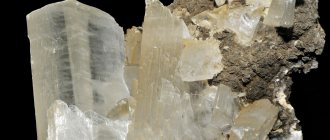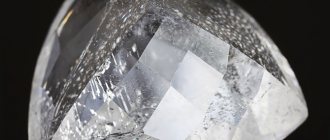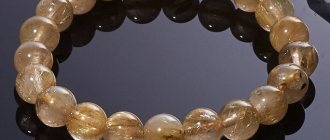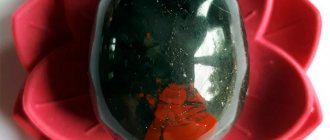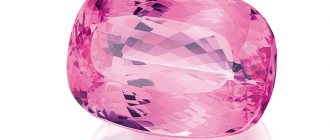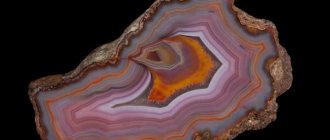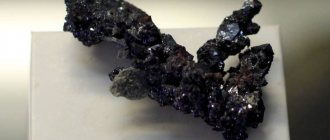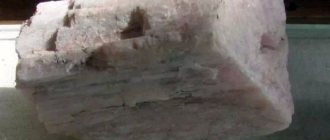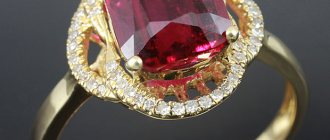| Category | Silicate minerals |
| Title in English | Nepheline |
| Formula | (Na,K)AlSiO4 |
| Group | Group of paramedics |
| Color | White, Grey, Brown |
| Stroke color | White |
| Shine | Bold, Glass |
| Transparency | Translucent, Transparent, Opaque |
| singonia | Hexagonal |
| Hardness | 6 |
| Cleavage | Imperfect |
| Density, g/cm³ | 2,55 — 2,66 |
| Kink | Uneven |
| origin of name | This mineral has one interesting feature: it becomes cloudy when it reacts with solutions of strong acids. Thanks to this, it received a name derived from the ancient Greek word νεφέλη, which translates as cloud. |
Nepheline is a natural mineral that belongs to the frame silicates. Its fragile crystals are transparent or translucent, usually colored white, light gray, green or yellow. Their shape is short-columnar, prismatic or tabular, with an uneven conchoidal fracture. Nepheline melts in acids. Among the impurities are calcium, magnesium, iron, chlorine, beryllium and gallium.
Historical reference
The mineral was discovered quite a long time ago - back in 1800. Since that time, active stone mining has been carried out, especially in the Russian Federation, where a huge deposit is being developed on the Kola Peninsula and a basin is operating. The stone often exists in wide sheets in the form of a transparent hexagonal rock.
The honor of discovering and naming nepheline belongs to the French mineralogist Rene-Juste Ahuy. Having found a beautiful stone in the vicinity of Naples, the scientist, who headed the Department of Mineralogy at the Museum of Natural History, carried out a number of manipulations usual for his time, as a result of which he revealed its main properties.
Interestingly, the mineral contains a sufficient amount of water, which makes it unlike other stones. Scientists distinguish several types of minerals depending on the microimpurities that they contain in minimal quantities.
Thus, eleolith is a stone with a large percentage of fatty impurities. The composition of the mineral includes silicon in large quantities. The percentage of impurities of other metals determines its color. So, thanks to chromium, the mineral comes out green.
This interesting stone has a glassy luster and is oily at the fracture. The dense structure and increased cleavage make it durable and reliable. The sparse palette of shades tends towards transparent, cloudy, watery. This gem has some similarities with spar and quartz, but it is purely external and does not affect the characteristics of the stone as a whole.
History of nepheline
Nepheline is able to dissolve in acids to form gel-like silicon compounds that look very similar to clouds. Due to this property, at the beginning of the 19th century, the mineralogist from France, Hauis, named the mineral “nepheline.” This word of Greek origin translates as "cloud". A little later, a decade later, another scientist Werner gave the gem a second name “eleolith”, which also has Greek roots and translated means “eleon”: fat, “lithos”: stone, and indicates the characteristic ability of the surface of the mineral - greasy shine. However, the first name still became more widespread.
Place of Birth
This mineral comes from igneous rocks. Its deposits are found all over the world.
This is interesting!
The largest deposits of stone were discovered in Russia - in the Murmansk region, in the Altai mountains, in the Krasnoyarsk Territory.
Nephelin, Odikhincha massif, Kotuy river
Nepheline deposits are also located in the following countries:
- Norway;
- Kenya;
- Tanzania;
- Sweden;
- Canada;
- Italy;
- Germany;
- Greenland.
This mineral is found in small deposits in the pores of volcanic rocks and frozen lava flows.
Nepheline deposits
— Advertising —
Large deposits of nepheline are known located on the Kola Peninsula, in the Krasnoyarsk Territory, in the Urals and Altai. Small crystals of this mineral form growths in the pores of volcanic rocks and have been discovered in countries such as Italy, Norway, Germany and Sweden. In addition, nepheline deposits are found in Canada and Greenland.
The igneous rock nepheline is a rock-forming mineral for alkaline igneous rocks (such as nepheline syenites and others) that are rich in sodium oxide and contain a low percentage of silica. It is less commonly found in pegmatite veins. Associated minerals for it are feldspar, biotites, ilmenites, and apatites. Nepheline was not found together with quartz. If there is an excess of silica in the rock, it turns into albite.
On the surface, nepheline undergoes weathering, and during its decomposition other minerals are formed, such as diaspores, elyolites, and thomsonites. The depressions that are visible in the rocks may be remnants of the former presence of nepheline in them.
Physical and chemical properties
| Property | Description |
| Formula | (Na,K)AlSiO4 |
| Hardness | 5,5 — 6 |
| Density | 2.55 - 2.66 g/cm³ |
| singonia | Hexagonal |
| Kink | Conchoidal, uneven |
| Cleavage | Imperfect |
| Fragility | fragile |
| Shine | Fatty |
| Transparency | Translucent or opaque |
| Color | White, water-transparent, light gray, yellowish, greenish, brownish |
The physical properties of the stone are affected by the impurities of the metals included in its composition. Beryllium, magnesium, iron, calcium and other elements give the stone transparency and color it in different shades. Without these impurities, the mineral is gray or brown in color and does not have good external jewelry qualities.
Description and external signs
The mineral was discovered in 1801 in Italy, in the Monte Somma deposit, R.J. Ayun, having first explored some of the properties of the stone, called it a “cloud”. Later, in 1808, A.G. Werner gave the mineral a different name, which also characterized its qualities “oil stone”, “fat stone”, “eleolith” - from the Greek. - “fat.”
The mineral can be found in alkaline rocks with voids as small prismatic aggregates up to 2 cm, flat plates or hexagonal plates that crystallize in a hexagonal structure as transparent aggregates. Nepheline reacts with acids and completely dissolves in hydrochloric acid (HCl), resulting in the formation of a SiO2 gel (silica cloud). When boiled for a long time, the solution becomes alkaline. After etching the mineral with orthophosphoric acid, it turns dark blue in a 0.25% solution of methylene blue.
Classification
The mineral is translucent, opaque, varies in shades depending on the location and depth of occurrence:
- White;
- Grey;
- Yellowish;
- Greenish;
- Brown;
- Reddish;
- Pink.
The mineral has a greasy, glassy sheen. The mineral is often associated in its properties and appearance with other minerals: analcime, natrolite, titanite, sodalite, libenerite, cancrinite, thomsonite. There are also several subspecies of nepheline: sodium nepheline, albite, nepheline hydrate, potassium, apatite, lithium, orthoclase, aegirine, kalsilite, microcline.
Chemical composition and physical properties
Nepheline (Na,K)AlSiO4 consists of:
- Sodium oxide (Na2O) from 13% to 16%;
- Aluminum oxide (Al2O3) from 31% to 33%;
- Silicon dioxide (SiO2) from 43% to 45%;
- Potassium oxide (K2O) from 5.5% to 6.5%;
- Calcium oxide (CaO) from 0.5% to 1.8%.
The mineral belongs to the class of silicates and has the following physical properties:
- Syngony: hexagonal;
- The form of the isolation is glassy grains, short prismatic crystals, tabular habit;
- According to the Mohs scale, the hardness of the mineral is 5.5 - 6;
- Density - 2.50-2.64;
- Molecular weight – 146.08;
- Fracture – brittle, conchoidal;
- The optical relief is low.
The mineral received IMA approved status until 1959. The mineral is mined in volcanic and alkaline rocks. Russia has the largest deposits and reserves of nepheline - apatite in the Khibiny Mountains on the Kola Peninsula. In the southern part of the Urals, Far East. Also deposits are located in Southern Norway, Italy, Sweden, Morocco, China, Africa, Tanzania, North America, Germany, Afghanistan.
| A country | Region | Field |
| Russia | Murmansk | Lovozero tundra |
| Kola Peninsula | Khibiny Mountains | |
| Kurochkin Log | ||
| Kemerovo | Kuznetsky-Alatau | |
| Kia-Shaltyrskoye |
Colors and varieties
Large nepheline crystal from Brazil
There are few varieties of nepheline. They are classified by color and chemical composition. Depending on the chemical properties, the following types are distinguished:
- albite;
- apatite;
- orthoclase;
- calsilite;
- nepheline hydrate;
- potassium;
- lithium;
- sodium nepheline.
The variety of shades is small:
- grey;
- borax;
- colorless;
- yellowish;
- bluish;
- pale green;
- brown;
- pinkish.
In addition to the chemical composition, the shade of the stone is also influenced by its location and depth.
Composition and structure
Most of the composition of the mineral is silicon. In addition to this element, nepheline contains a huge amount of various impurities in the form of calcium, magnesium, iron, beryllium, chlorine and even gallium. As for the structure of the mineral, it resembles a slightly distorted tridymite. Alkali metal cations are located in large cavities of the structure. The arrangement of some cations distorts the structure so that it almost completely loses its plane of symmetry. Crystallization of nepheline occurs in the hexagonal system. In this case, large granular aggregates are formed, and sometimes crystals in the form of short prisms can be found.
The crystals are quite rare, mainly found in cavities of alkaline rocks. In deposits, the stone can be presented in the form of thick hexagonal tablets or in the form of short prisms. The mineral is characterized by continuous granularity, and the grains themselves are irregular in shape. Most often, the stone occurs in the form of large monolithic layers.
Compared to feldspars, the mineral nepheline is not as common. Its formation occurs exclusively in magma, where the silica content is reduced. It is impossible to find the mineral in rocks with a high content of quartz.
Most of the composition of the mineral is silicon
Among other characteristics, hardness should be highlighted, which reaches 6 points on the Mohs scale. At the same time, the density is at an average level. As for cleavage, in this case it is imperfect. In most cases, the mineral has a glassy luster, but in some varieties it is absent.
We also recommend reading:
The history and curse of the Kohinoor stone The marvelous ametrine stone Characteristics of larimar and its main properties Selection of stones by date of birth
The color scheme cannot be called rich. Nepheline is presented as colorless minerals or in pink, green and gray shades. The stone reacts with mineral acids to form flocculated silica. But acids must have an average concentration. If exposed to other substances that exhibit acidic properties, the mineral may change its color to red or brown. Nepheline is one of the main representatives of alkaline rock minerals.
The varieties of nepheline depend on the presence of impurities in its composition. For example, if divalent iron predominates in a mineral, it will acquire a red tint. Sometimes it may have a purple color, but such stones are extremely rare.
Medicinal properties
Nepheline
The therapeutic effect of nepheline on humans is associated primarily with its positive effect on the state of the nervous system. The stone calms and helps relieve fatigue and stress.
In addition, staring at a nepheline crystal for a few minutes every day improves vision.
Yellow-gray nepheline normalizes the functioning of the gastrointestinal tract, increases appetite and improves metabolic processes.
In general, the stone has a tonic effect on the human body and helps in the prevention of various diseases.
Interesting facts about nepheline:
- Nepheline has been known to mankind for a long time and has always been considered one of the most powerful amulets for the home. When building a new home, they used to place a raw stone under the threshold. In the house it is also placed above the front door to protect oneself from bad people, envy and anger.
- Interestingly, nepheline helps its owner in self-knowledge, as a result of which a person’s life improves.
Areas of application
Nepheline is used for crafts, in particular, figurines, caskets, ashtrays, and ink utensils were made from it in the past.
Apatite-nepheline ore, Khibiny
Nepheline found its use in tanning leather to give it strength and flexibility. Nepheline is used in glass and ceramics factories.
The production of green glass occurs thanks to this mineral. In the ceramics industry, nepheline easily replaces feldspar.
Glazed dishes and tiles are made using nepheline. In both cases, nepheline raw materials are supplied in the form of flour, which is obtained at mining enterprises.
The textile industry uses nepheline to impregnate fabrics to give them fire- and acid-resistant properties. To do this, the mineral is dissolved in strong acids and a glassy mass is obtained, with which the fabric is impregnated. Wood can be treated in a similar way, which will ultimately protect it from harmful external factors and extend its service life.
The main use of nepheline at present is the production of aluminum. Nepheline is the second most important mineral after bauxite, especially important in the production of alumina, which is the basis for obtaining pure metal. In addition, soda, potash, some types of sludge, and silica gel are by-products during the production of alumina.
Branches of application of nepheline
Nepheline has found application in the glass and ceramic industries, in the manufacture of clay dishes, which are coated with glaze.
The mineral is an effective means for tanning leather, so that after treatment with special solutions it becomes flexible and durable. Workwear is impregnated with mixtures based on crushed nepheline to give it a water-repellent effect and resistance to fire. Nepheline imparts similar qualities to wood products. Due to its aluminum content, nepheline is in demand in the production of light alloys, which are widely used in the aviation industry and mechanical engineering. In addition to such valuable industrial qualities, nepheline also remains a valuable ornamental stone. On its basis, figurines, boxes, figurines, ashtrays and other items for interior decoration are created. High-quality jewelry examples of this gem suitable for cutting are rare, and therefore jewelry with it is also rarely made. More common are nepheline talismans and amulets, which are used as decorations.
Decorations and prices
Nepheline Ring
Jewelry with nepheline inserts is very rare. Not every craftsman is able to properly process this fragile mineral, and the cost of complex work is not justified by the final price of the product.
Nepheline is mainly sold in the form of crafts and rough stones. For one such nugget weighing 70-100 grams, they pay an average of $4-6. The price of crafts and polished stones increases two to three times, depending on the weight of the product.
How to care for nepheline
As a fairly fragile stone, nepheline is protected from mechanical stress, shock and scratches.
Store it in separate boxes, wrapped in soft cloth. To clean nepheline products, use running water or a weak soap solution. To avoid damaging the stone, do not use acid-based cleansers, as this may cause it to change color. After cleansing, the mineral is dried well.
Who is suitable according to the zodiac
Nepheline jewelry is suitable for all zodiac elements, but the most favorable influence is given to the stubborn zodiac signs: Aries, Taurus.
- For Taurus – helps to establish relationships with family and work colleagues, will teach its owner to better understand other people, to be more flexible and sociable.
- For Aries - it will serve as a good talisman, allowing you to foresee troubles in advance, and will protect its owner from numerous mistakes and mistakes.
For other zodiac signs, this mineral has an average degree of compatibility. It does not help everyone, only those with whom a strong energetic connection is established.
Important!
Among the entire zodiac circle there are no signs that would be harmed by this stone. In the worst case, it will turn out to be neutral, useless.
For water signs of the zodiac: Pisces, Cancer, Scorpio, it is better to use stones of gray, brown, and white shades.
Fiery - Leo, Sagittarius, Aries, choose talismans with brown, brown, pink or red nepheline stones.
Earthly - Taurus, Virgo, Capricorn, use green or brown minerals.
The magical properties of nepheline
Nepheline is a powerful amulet for the home of its owner; it reliably protects against evil, envious people and the evil eye.
Even when building a house, it is recommended to place an unprocessed piece of nepheline under the threshold. In an already built home, the mineral is placed immediately above the front door. In addition, the magical properties of nepheline are aimed at making its owner strive to know himself, strengthening his self-esteem and gaining confidence in his own abilities. Nepheline promotes the manifestation and development of hidden abilities and talents, enhances human creativity. Thanks to these properties, nepheline talismans are recommended for actors, artists, poets, writers and other representatives of creative professions. Also, the powers of the gem are actively used by various kinds of sorcerers and psychics who believe that nepheline increases their supernatural abilities.
Talismans, amulets, amulets
Ball on a stand, Nepheline
It is most favorable to wear for people who are self-confident, purposeful in their actions, who go ahead. This mineral will allow such people to find their purpose without destroying everything in their path, avoiding all adversity and problematic situations with light humor.
Shy people are recommended to wear a nepheline talisman, which will give the owner charisma and help him find a common language with his interlocutors.
It is also important to choose the right stone shape and metal for cutting it. Career-oriented people should use figures in the form of a triangle, parallelogram, square, prism in a gold or platinum frame.
For those who have the goal of starting a family and having children, round-shaped figurines framed in gold or silver are suitable. Students, schoolchildren and people involved in science and education are recommended to wear rings with nepheline.
It allows people of creative professions to find a muse and follow the path of personal development.
Sources and literature
- Nephelin // Morshyn - Nikish. - M.: Soviet Encyclopedia, 1974. - (Great Soviet Encyclopedia: [in 30 volumes] / chief editor A. M. Prokhorov; 1969-1978, vol. 17).
- Minerals: Reference. - M.: Nauka, (2003), vol. V, issue 2, 17-52
- Samsonova N.S. Minerals of the nepheline group. M., 1973
- Yakovenchuk V.N., Ivanyuk G.Yu., Konopleva N.G., Korchak Yu.A., Pakhomovsky Ya.A. Nepheline of the Khibiny alkaline massif (Kola Peninsula). - ZRMO, 2010, part 139, issue. 2, pp. 80-91
5 / 5 ( 1 voice )
Zodiac signs
A ball of nepheline
Of all the signs of the zodiac, nepheline distinguishes Aries and Taurus. He especially favors these representatives of the zodiac circle, helping them find their purpose in society and establish relationships with others.
The stone will not ignore the other signs of the Zodiac, provided full energetic contact is established with it:
- Capricorns will gain faith in themselves.
- Aquarians, with the help of nepheline, will be able to cut off unnecessary connections, which will have a beneficial effect on their family relationships.
- Pisces will be able to find the right solution in achieving career heights.
- With the help of the mineral, Gemini will get closer to children and find common ground with them.
- Cancers will gain strength and courage to make changes in life.
- Leos can use the power of nepheline to find their soulmate.
- For Virgos, a talisman with a gem will bring good luck and profit.
- For Libra, the stone will help restore mental balance and get rid of worries.
- Nepheline will help Scorpios in amorous matters.
- Sagittarius will be able to moderate their jealousy and temper, which will help improve relationships with their loved one.
Regardless of zodiac affiliation, nepheline will help shy people overcome their fear of their interlocutor and reveal their charisma.
Interesting Facts
Since ancient times, it has been generally accepted that nepheline is endowed with magical properties. It was believed that the stone is a very powerful energy protection for housing. In addition, there are beliefs that nepheline is able to protect its owner from evil and dashing glances.
It is also interesting that raw nepheline is placed under the threshold of a future house, for which the foundation has already been prepared. If the house is already ready, then the stone is suspended above the entrance.
It is believed that the power of the mineral can help its owner get to know himself better and achieve success in any activity.
